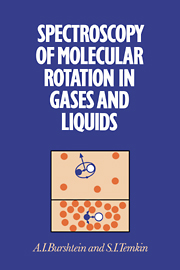Book contents
- Frontmatter
- Contents
- 0 Introduction
- 1 Rotational relaxation
- 2 Orientational relaxation in dense media
- 3 Transformation of isotropic scattering spectra
- 4 Quantum theory of spectral collapse
- 5 Rotational relaxation: kinetic and spectral manifestations
- 6 Impact theory of orientational relaxation
- 7 Rotation and libration in a fluctuating cell
- Appendix 1
- Appendix 2
- Appendix 3
- Appendix 4
- Appendix 5
- Appendix 6
- Appendix 7
- Appendix 8
- Appendix 9
- References
- Index
6 - Impact theory of orientational relaxation
Published online by Cambridge University Press: 06 November 2009
- Frontmatter
- Contents
- 0 Introduction
- 1 Rotational relaxation
- 2 Orientational relaxation in dense media
- 3 Transformation of isotropic scattering spectra
- 4 Quantum theory of spectral collapse
- 5 Rotational relaxation: kinetic and spectral manifestations
- 6 Impact theory of orientational relaxation
- 7 Rotation and libration in a fluctuating cell
- Appendix 1
- Appendix 2
- Appendix 3
- Appendix 4
- Appendix 5
- Appendix 6
- Appendix 7
- Appendix 8
- Appendix 9
- References
- Index
Summary
Debye's theory, considered in Chapter 2, applies only to dense media, whereas spectroscopic investigations of orientational relaxation are possible for both gas and liquid. These data provide a clear presentation of the transformation of spectra during condensation of the medium (see Fig. 0.1 and Fig. 0.2). In order to describe this phenomenon, at least qualitatively, one should employ impact theory. The first reason for this is that it is able to describe correctly the shape of static spectra, corresponding to free rotation, and their impact broadening at low pressures. The second (and main) reason is that impact theory can reproduce spectral collapse and subsequent pressure narrowing while proceeding to the Debye limit.
The above capabilities of impact theory are illustrated in preceding chapters by consideration of the isotropic scattering spectrum, which consists of one Q-branch. The peculiarity of the present problem is that in the spectrum of orientational relaxation there are always several branches, and, generally speaking, one cannot consider their transformation independently. The very first attempt to build a quasi-classical impact theory of rotational structure drew one's attention to this fact as being of principal importance. It made the theory similar to the quantum theory of unresolved atomic spectra, whose Stark or Zeeman components interfere with each other during collisions. Interference of the same nature takes place between rotational branches of vibrational spectra, described classically. Increase of collisional frequency causes spectral collapse, but very rarely does an atomic spectrum narrow afterwards.
- Type
- Chapter
- Information
- Spectroscopy of Molecular Rotation in Gases and Liquids , pp. 198 - 223Publisher: Cambridge University PressPrint publication year: 1994



